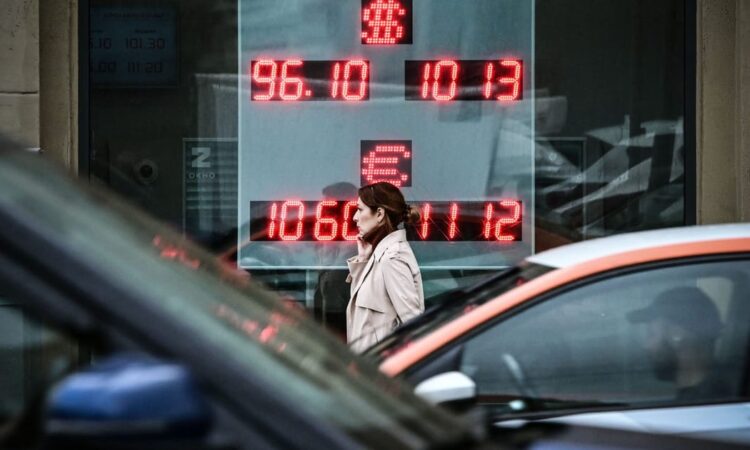
Russia’s central bankers are expected to hike interest rates at an emergency meeting on Tuesday to respond to an accelerated weakening of the ruble and a deteriorating economy, as the war against Ukraine and sanctions bite hard.
The big paradox for policy experts in Moscow is that the currency is plummeting just as oil prices — Russia’s export lifeblood and budgetary mainstay — have risen. Prices for Russian Urals grade crude are rallying beyond an internationally agreed price cap of $60 per barrel, but the ruble spiked to more than 102 to the dollar on Tuesday. That’s almost half the value it fetched in June 2022, when it traded at 54 to the dollar.
The central bank last raised its key interest rate to 8.5 percent from 7.5 percent on July 21, its first hike since September 2022.
At the time, Governor Elvira Nabiullina warned that more hikes may be necessary if the economic fallout of the Kremlin’s war in Ukraine worsened, but no policy meeting was scheduled until September.
On Monday the ruble, which is supposed to trade under a “managed float” regime, slid to a 16-month low against the dollar, paring losses only after the extraordinary meeting was announced.
Various factors have weighed on the ruble in recent days. Less than a week ago, Moscow said it would cut oil exports by 300,000 barrels a day from September, reluctantly following Saudi Arabian efforts to prop up crude prices by throttling supply.
In addition, military activity in the Black Sea has increased considerably since Russia abandoned a UN-backed deal to guarantee Ukrainian grain exports, casting doubt over Russia’s own ability to guarantee its own energy and agricultural exports.
This depreciation despite higher Russian oil prices has led some to speculate the government could be deliberately allowing the currency to weaken to help it meet its budget obligations. A lower ruble allows authorities to carry on paying state workers with the proceeds of fewer barrels of oil, albeit at the cost of making imported consumer goods more expensive.
But Nabiullina has dismissed such claims as “conspiracy theories”.
The central bank has since announced that it will not purchase any more foreign exchange on behalf of the finance ministry for the rest of this year in a bid to prevent further ruble weakening.
Worsening inflation outlook
Russian interest rates had peaked at 20 percent in February 2022, after a series of emergency hikes to cool inflation which had reached 17.8 percent as well as to defend the ruble in the wake of Russia’s invasion of Ukraine.
But the ruble’s recent depreciation has worsened the inflation outlook.
Official statistics from the central bank last week showed the annual inflation rate accelerating to 4.3 percent in July from 3.25 percent in June. The central bank — which targets a 4 percent inflation rate — is now expecting inflation to average between 5 and 6.5 percent this year, a figure that is significantly below the 11.1 percent expected by Russian households.
Some economists, such as Johns Hopkins University’s Steve Hanke, claim the true inflationary picture could be even higher if a method that assumes goods and services should have the same price in two countries when compared in the same currency is used to calculate the figure. By Hanke’s measure, Russian inflation is closer to 65 percent.
Markets are now expecting the CBR to raise rates again on Tuesday in a sign that the war is increasingly hurting the economy, depressing export revenues, depriving the labor force of workers and widening the government’s budget deficit.
The country also continues to grapple with a large capital exodus by rich nationals who are finding ever more creative ways of liberating their purchasing power on the international market — often with the help of offshore accounts.
According to a report from the Central Bank of Russia last month, a record $253 billion was pulled out of the Russian economy since the beginning of its war with Ukraine in February 2022, with $27 billion of it in 2023.
“The recovery of imports combined with the decline in exports ensured a significant decrease in the current account balance in 2023. This, in turn, stimulated a sharp transition from the strengthening of the ruble to mid-2022 to its sharp weakening in 2023” a report from the bank stated at the time.
But it’s not all doom and gloom for the Russian economy. The national statistics agency Rosstat reported on Friday that growth had increased to 4.9 percent in the second quarter compared with a 1.8 percent decline in the first quarter of the year.
The CBR expects year-on-year growth of 3.6 percent in Q3 and 1.5 percent in Q4 2023.





